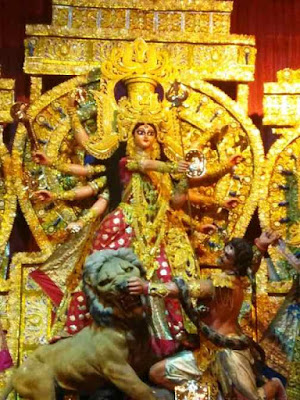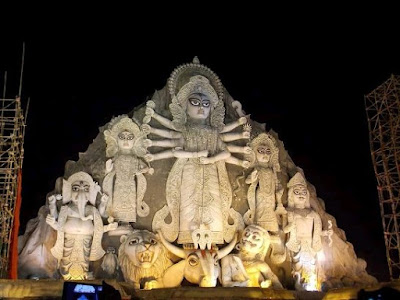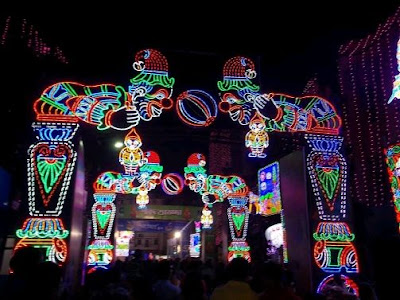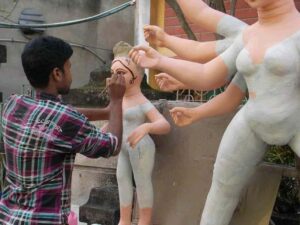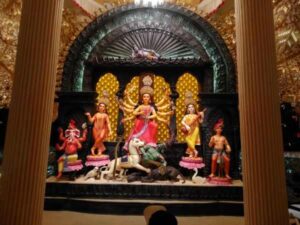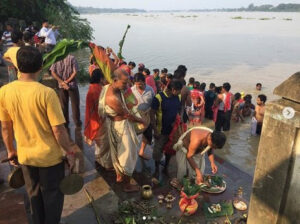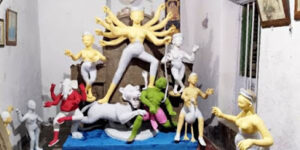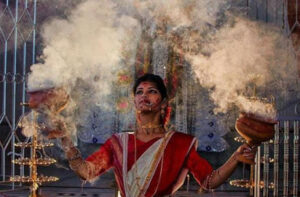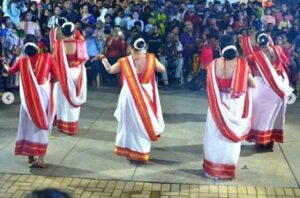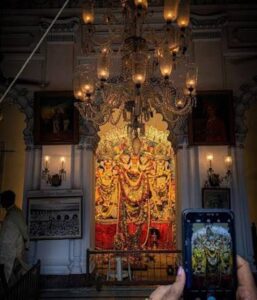Durga Puja, the biggest festival of Bengalis, is celebrated with great enthusiasm in eastern India. However, have you ever wondered how, when, and why the Durga Puja celebration started. We will take you to the lanes of history to understand the significance of Durga Puja.
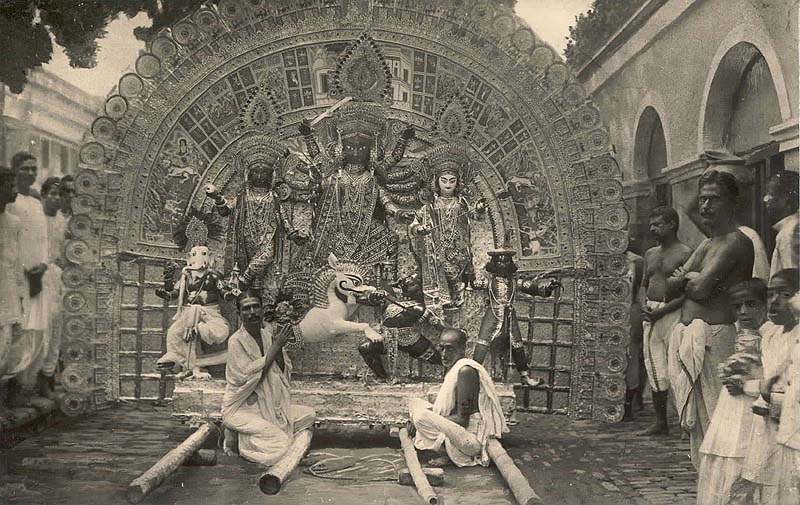
Initially, it was limited to celebrations only by the zamindars (landowners). Towards the latter part of the 19th century, community-level Durga Puja with maas participation started in Bengal, and now it is celebrated with all kinds of extravaganza.
Story of Durga Puja – The victory of good over evil
Proud of the boon received from Bramha, he thought that he is invincible. To everyone’s horror, he unleashed a reign of terror. He even attacked Devlok, the abode of Gods.
Due to the blessings from Bramha, no male god was able to defeat the demon king. His brutality was on the rise day by day. In these disturbing circumstances, Brahma, Vishnu, and Shiva combined all their powers to give birth to Durga. To make her powerful, Gods presented their weapons to her.
On the day of Mahalaya, Goddess Durga killed the demon king and freed the world from his cruelty. Durga Puja, the festival marks the victory of the Goddess Durga over the demon king Mahishasura. It celebrates the triumph of divine feminine power.
Durga Puja Origin – Display of power and prestige
The history of Puja in Bengal dates back to the Mughal era in 1600. Durga Puja was revived only a few centuries ago by wealthy Hindu landlords (Zamindars). The pujas were expressions of their burgeoning power in the wake of the diminishing strength of their Mughal overlords. The wealthy Hindu elites implicitly competed with each other through the glory and grandeur of the celebrations.
Raja Kamsanarayan, a landlord of the Taherpur region of Rajshahi, in present-day Bangladesh, organized the first Durga Puja.
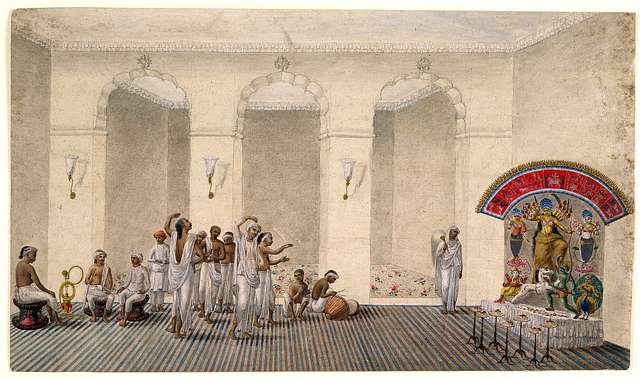
Upon assuming control of the zamindar in 1583, Kamsanarayan desired to perform the Ashvamedha, the Vedic horse sacrifice. The courtiers and the Pandits opposed this idea. They advised him to perform Durga Puja introduced by Lord Ram of the Ramayan. Lord Ram had untimely invoked the Goddess from slumber.
He gave in to the wishes of the Pandits. Raja Kansanarayan spent almost Rs. 9 Lakh(At present estimation, around six hundred crores of rupees) for the Durga Puja arrangement and grand celebrations.
Soon, other landlords close to the empire, such as Bhabananda Majumdar of Nadia, followed in the footsteps. Other Hindu Kings pitched in, and the puja spread far and wide to Gour, RajMahal, Murshidabad, and Krishnagar. These domestic Durga Pujas were also open to the general public.
The Puja at Kolkata was started in the early seventeenth century by one of Bengal’s well-known Landlord, LakshmiKant Gangopadhyay. Lakshmi Kant had also built a place of worship called Aatchala, after the distinctive eight pairs of pillars in its construction. It was at Aatchala in 1610 that Lakshmi Kant and Raja Basanta Rai(builder of Kalighat temple) celebrated the first autumn Durga Puja.
After 1610 his family, who had now come to be known as the Sabarna Rai Choudhury’s, continued to celebrate the Durga Puja at Aatchala in their ancestral home at Barisha(present-day Behala). These pujas used to be open to the general public. The images were not immersed in the water after the celebration but reused every year.
Durga Puja History – Rebellion against Mughal rule
Durga Puja in Bengal served as a crucial economic and political indicator of the complex shifting relationships between zamindars, Mughal overlords (nawabs), and British power in the form of the East India Company.
The Bengali zamindars of the 1700s, such as Raja Krishnachandra Rai of Nadia and Rani Bhavani, are said to have been well known for their resistance to the Mughal rule. The famous Krishnagar royal Durga puja started way back in 1683.
Raja Krishnachandra Rai of Nadia, Raja Naba Krishna Deb of Shovabazar, Rani Bhavani, and others conspired with the British to oust Siraj-ud-daula, the young Nawab Of Bengal, from power.
At the Battle of Plassey, fought in June 1757, the British, under the leadership of Robert Clive, won a decisive victory over the Nawab.
To commemorate this victory, later in the same year, 1757, Raja Navakrishna Deb of ShovaBazar Rajbari initiated grand scale celebrations of the Durga Puja. Lord Robert Clive offered thanksgiving at the Shovabazar Durga puja. Read about the legacy of Sovabazar Rajbari. The participation of Englishmen gracing the family Durga Puja was a matter of great prestige for the host.
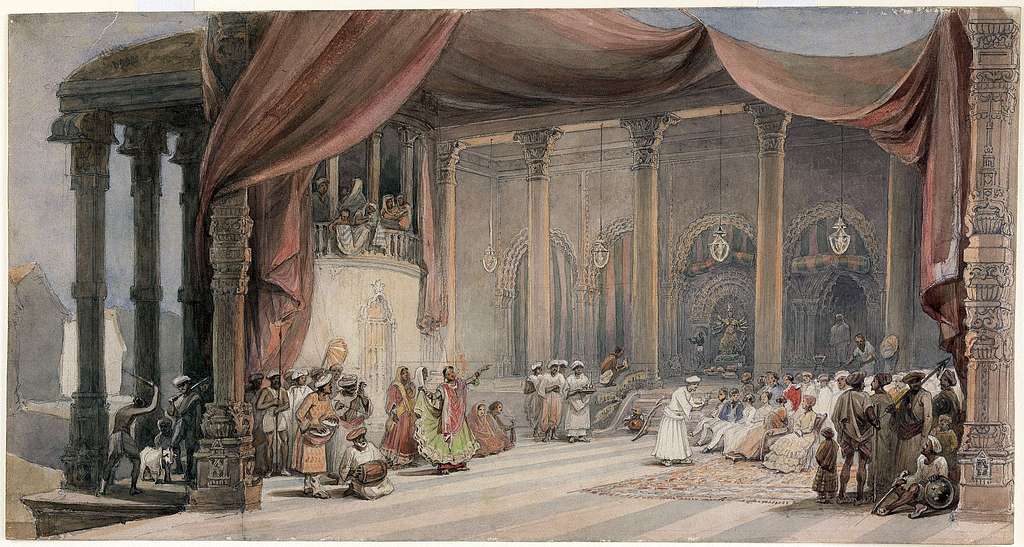
To flaunt their wealth, the upcoming merchant class of Kolkata followed this trend of puja. These grand pujas in the period of British rule captured the public imagination and triggered the tradition that now flourishes in Bengal. Durga Puja became a means of demonstrating wealth and prestige.
However, there were exceptions. Rani Rashmoni, the founder of the Dakshineswar Kali Temple, Kolkata, used to celebrate Durga Puja at her residence in a traditional ceremony. She had a dispute with Englishmen and did not entertain them.
Barowari Durga Puja – Community Gathering
Initially, only the wealthy Hindu elite class celebrated the Durga Puja in Bengal. In the year 1790, some men were stopped from taking part in a household Durga Puja. Twelve of them formed a committee and organized the first community puja at Guptipara, Hooghly.
Since twelve friends had organized this puja, the public community puja became famous as barowari. The literal meaning of Barowari is the Bengali words baro, which means 12, and yari, meaning friendly relationship.
As costs escalated and the economic power of the aristocracy declined, the grand-scale domestic pujas began to yield to group celebrations. The public celebrations arranged by community clubs, which developed from this process of democratization, are still referred to by Bengalis as Barowari pujas.
The first Barowari Durga Puja was organized in Kolkata by Bhowanipore Sanatan Dharmotsahini Sabha in 1909 by the banks of Adi Ganga, at Balaram Bose Ghat Road, Bhowanipore. The puja is still held with the same strict tradition, culture, and heritage. Syama Prasad Mukherjee, the founder member of BJP, was associated with this organization. The worship site has a historical significance, as self-immolation during the 1900s was practiced ( Sati Daha) there.
Durga Puja – Mother India And Indian Independence Movement
During the Indian independence movement, Durga Puja played a prime role in uniting the people of Bengal. The mission was to evoke the spirit of patriotic awakening among the sons of Bengal. The Goddess became the symbol of strength and divinity in the freedom struggle. British officers were depicted as the demon Mahisasura, whom Durga(Mother India) has slain in a battle.
Bankim Chandra Chattopadhyay, in his glorious novel Anandmath, written in 1882, conceived the idea of the mother India, in the form of goddess Durga. That was meant to inspirit the Indian soul with devotion towards the country. Bande Mataram, a poem from the novel, became the famous battle cry of nationalism.
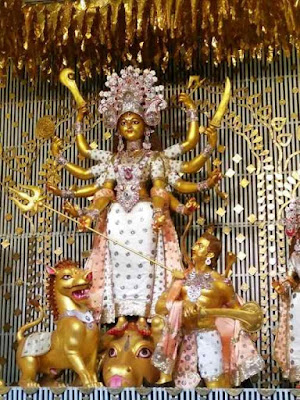
In the 1920s, as per Mahatma Gandhi’s instructions, to abolish untouchability, several Bengali Hindu leaders called for religious celebrations embracing everyone, from whatever caste or class background. That led to the concept of the sarbajanin or all-inclusive Puja. The festival became open to everyone regardless of birth or residence.
The purpose of Sarbojanin Durgotsav was to terminate the differentiation of caste, creed, religion, rich and poor in various sections of the society.
The veteran leader Bal Gangadhar Tilak had by then popularised large-scale community Ganpati pujas in Maharashtra to establish a sense of national identity, bridging caste divides. Taking a cue from him, the freedom fighters, both from the Congress and other revolutionary streams, actively took part in the Durga Puja festival to further their political cause.
The first Sarbojanin Durgotsav in Bengal was introduced by Late Atindra Nath Bosu, who established Simla Byayam Samity in the year 1926. Before this, no puja had used the word Sarbojanin. The female members of the Samity took active participation in the struggle for freedom.
Many national leaders made their presence at Bagbazar Durgotsav. During the Swadeshi movement, the organization held an exhibition of swadeshi industrial products. Netaji Subhash Chandra Bose was the president of this organization in 1938-1939. The Puja celebrated its centennial year in 2018.
Durga Puja – Present Day
Today, Durga Puja means adorning the best clothes, pandal hopping, fun and entertainment over cultural performances, and great food. People wait for the whole year for the five days of Durga Puja. The festival also marks the homecoming of residents living outside Bengal.
In West Bengal about, 28000 community pujas are organized. Bengalis have taken their culture to distant lands. Today, Durga Puja is celebrated worldwide from Europe to the United States on a smaller scale. Durga Puja In Bangalore – famous pandals you must visit.
Subscriptions are raised for the construction of theme pandals(temporary shrines), larger-than-life idols, and electric decorations. The organizers also receive corporate sponsorship. The spirit of competition and ostentatious display endures, and the operating logic often is, mine is better than yours.
Durga Puja has economic significance too. A report published by Assocham in 2013 states that 10% GDP of Bengal comes from this 5-day celebration of Durga Puja. The earning of artisans, Dhakis, local businesses, and also the food and beverage makers are dependent on this festival.
Durga Puja was never just a religious festival. It impacted the social and cultural life of the generations in banglasphere.
Also Read: History Of Kali Puja In Bengal
